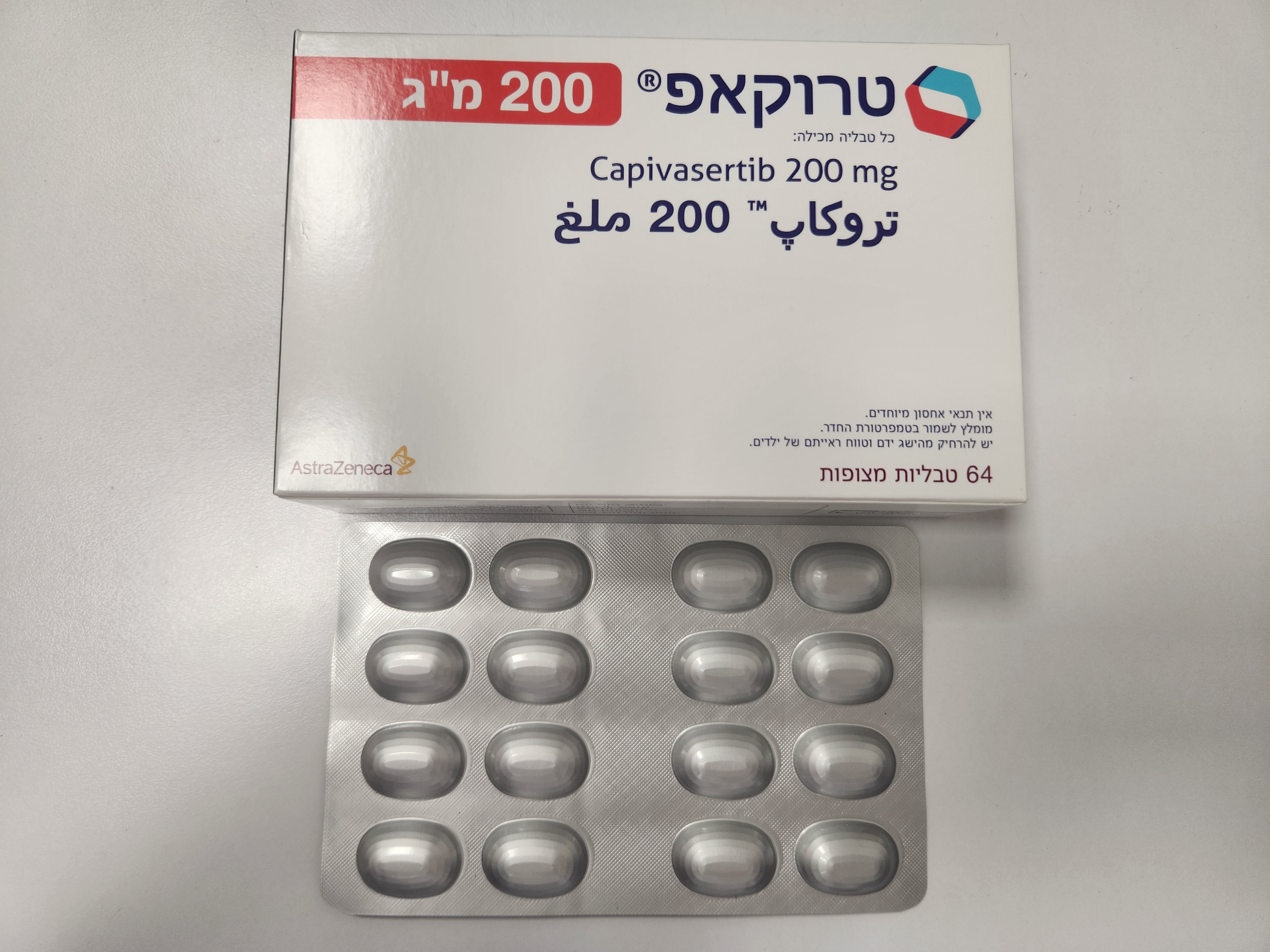Quest for the right Drug

טרוקאפ 200 מ"ג TRUQAP 200 MG (CAPIVASERTIB)
תרופה במרשם
תרופה בסל
נרקוטיקה
ציטוטוקסיקה
צורת מתן:
פומי : PER OS
צורת מינון:
טבליות מצופות פילם : FILM COATED TABLETS
עלון לרופא
מינוניםPosology התוויות
Indications תופעות לוואי
Adverse reactions התוויות נגד
Contraindications אינטראקציות
Interactions מינון יתר
Overdose הריון/הנקה
Pregnancy & Lactation אוכלוסיות מיוחדות
Special populations תכונות פרמקולוגיות
Pharmacological properties מידע רוקחי
Pharmaceutical particulars אזהרת שימוש
Special Warning עלון לרופא
Physicians Leaflet
Pharmacological properties : תכונות פרמקולוגיות
Pharmacodynamic Properties
11.2 Pharmacodynamics Exposure-Response Relationships The exposure-response relationship and time course of pharmacodynamic response for the effectiveness of capivasertib have not been fully characterized. Exposure-response relationships were observed for diarrhea (CTCAE Grade 2 to 4), rash (CTCAE Grade 2 to 4) and hyperglycemia (CTCAE Grades 3 or 4) at doses of 80 to 800 mg (0.2 to 2 times the approved recommended dosage). Cardiac Electrophysiology At the recommended TRUQAP dose, a mean increase in the QTc interval > 20 ms was not observed.
Pharmacokinetic Properties
11.3 Pharmacokinetics Capivasertib pharmacokinetic parameters are presented as the mean [%coefficient of variation (%CV)], unless otherwise specified. The capivasertib steady-state AUC is 8,069 h·ng/mL (37%) and Cmax is 1,371 ng/mL (30%). Steady-state concentrations are predicted to be attained on the 3rd and 4th dosing day of each week, starting week 2. Capivasertib plasma concentrations are approximately 0.5% to 15% of the steady state Cmax during the off- dosing days. Capivasertib AUC and Cmax are proportional with dose over a range of 80 to 800 mg (0.2 to 2 times the approved recommended dosage). Absorption Tmax is approximately 1-2 hours. The absolute bioavailability is 29%. Effect of Food No clinically meaningful differences in capivasertib pharmacokinetics were observed following administration of TRUQAP with a high-fat meal (approximately 1,000 kcal; fat 60%) or a low-fat meal (approximately 400 kcal; fat 26%). Distribution The steady state oral volume of distribution is 1,847 L (36%). Capivasertib plasma protein binding is 78% and the plasma-to-blood ratio is 0.71. Elimination The half-life is 8.3 hours and the steady-state oral clearance is 50 L/h (37% CV). Renal clearance was 21% of total clearance. Metabolism Capivasertib is primarily metabolized by CYP3A4 and UGT2B7. Excretion Following a single radiolabeled oral dose of 400 mg, the mean total recovery was 45% from urine and 50% from feces. Specific Populations No clinically significant differences in capivasertib pharmacokinetics were observed based on race/ethnicity (including White, Asian, Black, American Indian or Alaskan Native, and Native Hawaiian or Other Pacific Islander), sex (88% females), body weight (32 to 150 kg), age (26 to 87 years), mild hepatic impairment (bilirubinULN or bilirubin > 1 to 1.5x ULN), or mild to moderate renal impairment (CLcr 30 to 89 mL/min). The effect of moderate (bilirubin > 1.5 to 3x ULN and any AST) hepatic impairment is not fully characterized. TRUQAP has not been studied in patients with severe (bilirubin > 3x ULN and any AST) hepatic impairment or severe renal impairment (CLcr 15 to 29 mL/min). Drug Interaction Studies Clinical Studies and Model-Informed Approaches Effect of Strong and Moderate CYP3A Inhibitors on Capivasertib: Itraconazole (strong CYP3A4 inhibitor) is predicted to increase capivasertib AUC by up to 1.7- fold and Cmax by up to 1.4-fold. Erythromycin and verapamil (moderate CYP3A inhibitors) are predicted to increase capivasertib AUC by up to 1.5-fold and Cmax by up to 1.3-fold. Effect of Strong and Moderate CYP3A Inducers on Capivasertib: Rifampicin (strong CYP3A4 inducer) is predicted to decrease capivasertib AUC by 70% and Cmax by 60%. Efavirenz (moderate CYP3A4 inducer) is predicted to decrease capivasertib AUC by 60% and Cmax by 50%. Effect of UGT2B7 Inhibitors on Capivasertib: Probenecid (UGT2B7 inhibitor) is not predicted to have a clinically meaningful effect on capivasertib pharmacokinetics. Effect of Acid Reducing Agents on Capivasertib: Rabeprazole (gastric acid reducing agent) did not have a clinically meaningful effect on capivasertib pharmacokinetics. Effect of Capivasertib on CYP3A Substrates: Concomitant use of TRUQAP increased midazolam (CYP3A substrate) AUC by 1.8-fold on day 4 and by 1.2-fold on day 7. Effect of Capivasertib on CYP2D6 Substrates: TRUQAP is predicted to increase desipramine (CYP2D6 substrate) AUC by up to 2.1-fold on day 4. Effect of Capivasertib on CYP2C9 Substrates: Concomitant use of TRUQAP with warfarin (CYP2C9 substrate) is not predicted to have a clinically meaningful effect on warfarin pharmacokinetics. Effect of Capivasertib on UGT1A1 Substrates: TRUQAP is predicted to increase raltegravir (UGT1A1 substrate) AUC by up to 1.7-fold on day 4. In-Vitro Studies Capivasertib inhibits BCRP, OATP1B1, OATP1B3, OAT3, MATE1, MATE2-K, and OCT2.

שימוש לפי פנקס קופ''ח כללית 1994
לא צוין
תאריך הכללה מקורי בסל
לא צוין
הגבלות
לא צוין
מידע נוסף
